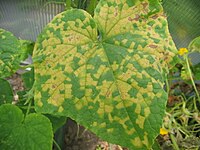
Coexistence of genetically different Varroa destructor in Apis mellifera colonies
Sign Up to like & getrecommendations! Published in 2019 at "Experimental and Applied Acarology"
DOI: 10.1007/s10493-019-00395-z
Abstract: The aim of this study was to investigate the genetic diversity of Varroa destructor parasitizing Apis mellifera colonies and to test for possible host–parasite association at the mitochondrial DNA (mtDNA) level. Six A. mellifera haplotypes… read more here.
Keywords: apis mellifera; varroa destructor; destructor; mellifera colonies ... See more keywords

Assessing interactive mixture toxicity of carbamate and organophosphorus insecticides in the yabby (Cherax destructor)
Sign Up to like & getrecommendations! Published in 2018 at "Ecotoxicology"
DOI: 10.1007/s10646-018-1973-x
Abstract: Carbamate (CB) and organophosphorus (OP) pesticides are commonly detected in aquatic ecosystems and predominantly occur as mixtures of varying complexity. These pesticides inhibit the activity of total cholinesterase (ChE) and thus have the potential to… read more here.
Keywords: destructor; activity; carbamate organophosphorus; mixture toxicity ... See more keywords

Evaluations of the Removal of Varroa destructor in Russian Honey Bee Colonies that Display Different Levels of Varroa Sensitive Hygienic Activities
Sign Up to like & getrecommendations! Published in 2018 at "Journal of Insect Behavior"
DOI: 10.1007/s10905-018-9672-2
Abstract: The removal of Varroa destructor was assessed in Russian honey bee (RHB) colonies with known levels of Varroa Sensitive Hygienic (VSH) and brood removal activities. The expression of grooming behaviour using individual bees was also… read more here.
Keywords: removal varroa; rhb colonies; destructor; bee ... See more keywords

Development of single nucleotide polymorphism markers specific to Apis mellifera (Hymenoptera: Apidae) line displaying high hygienic behavior against Varroa destructor, an ectoparasitic mite
Sign Up to like & getrecommendations! Published in 2019 at "Journal of Asia-pacific Entomology"
DOI: 10.1016/j.aspen.2019.08.005
Abstract: Abstract To control Varroa destructor, an ectoparasitic mite, a honey bee line possessing high hygienic behavior (HHB) against this mite has been bred in South Korea. However, a method that can diagnose and assess the… read more here.
Keywords: hygienic behavior; polymorphism; mite; line ... See more keywords

Environment or beekeeping management: What explains better the prevalence of honey bee colonies with high levels of Varroa destructor?
Sign Up to like & getrecommendations! Published in 2017 at "Research in veterinary science"
DOI: 10.1016/j.rvsc.2017.01.001
Abstract: Varroa destructor is one of the major threats to honey bee colonies. The mite abundance in the colonies is affected by environmental conditions as well as by beekeeping management. The aim of this study was… read more here.
Keywords: bee colonies; varroa destructor; destructor; beekeeping management ... See more keywords

Genome-wide identification of miRNAs and target regulatory network in the invasive ectoparasitic mite Varroa destructor.
Sign Up to like & getrecommendations! Published in 2021 at "Genomics"
DOI: 10.1016/j.ygeno.2021.05.028
Abstract: Varroa destructor is an ectoparasite mite that attacks bees leading to colony disorders worldwide. microRNAs (miRNAs) are key molecules used by eukaryotes to post-transcriptional control of gene expression. Nevertheless, still lack information about V. destructor… read more here.
Keywords: genome wide; wide identification; varroa destructor; destructor ... See more keywords

Using Surrogate Insects in Acid Bioassays for Development of New Controls for Varroa destructor (Arachnida: Varroidae)
Sign Up to like & getrecommendations! Published in 2022 at "Journal of Economic Entomology"
DOI: 10.1093/jee/toac120
Abstract: Abstract Resistance to traditional synthetic compounds by Varroa destructor Anderson andTrueman and shortcomings of the organic acid class of acaracides commonly used in varroa management requires continual development of new controls. V. destructor, however, are… read more here.
Keywords: development new; insects; destructor; varroa destructor ... See more keywords

Assessing Repeated Oxalic Acid Vaporization in Honey Bee (Hymenoptera: Apidae) Colonies for Control of the Ectoparasitic Mite Varroa destructor
Sign Up to like & getrecommendations! Published in 2022 at "Journal of Insect Science"
DOI: 10.1093/jisesa/ieab089
Abstract: Abstract The American beekeeping industry continually experiences colony mortality with annual losses as high as 43%. A leading cause of this is the exotic, ectoparasitic mite, Varroa destructor Anderson & Trueman (Mesostigmata: Varroidae). Integrated Pest… read more here.
Keywords: honey; destructor; vaporization; mite varroa ... See more keywords

Understanding the Enemy: A Review of the Genetics, Behavior and Chemical Ecology of Varroa destructor, the Parasitic Mite of Apis mellifera
Sign Up to like & getrecommendations! Published in 2022 at "Journal of Insect Science"
DOI: 10.1093/jisesa/ieab101
Abstract: Abstract Varroa destructor (Mesostigmata: Varroidae) is arguably the most damaging parasitic mite that attacks honey bees worldwide. Since its initial host switch from the Asian honey bee (Apis cerana) (Hymenoptera: Apidae) to the Western honey… read more here.
Keywords: ecology; genetics; honey; varroa ... See more keywords

Mitochondrial loci enable specific qPCR detection of the pathogen causing contemporary impatiens downy mildew epidemics.
Sign Up to like & getrecommendations! Published in 2021 at "Plant disease"
DOI: 10.1094/pdis-05-21-0933-re
Abstract: Impatiens downy mildew (IDM) disease is a primary constraint on the production of Impatiens walleriana, a popular and economically important floriculture plant. IDM is caused by the biotrophic oomycete Plasmopara destructor that emerged as a… read more here.
Keywords: pathogen; downy mildew; detection; destructor ... See more keywords

The impatiens downy mildew epidemic in the U.S. is caused by new, introgressed lineages of Plasmopara destructor with prominent genotypic diversity and high evolutionary potential.
Sign Up to like & getrecommendations! Published in 2022 at "Plant disease"
DOI: 10.1094/pdis-08-22-1872-re
Abstract: Impatiens downy mildew (IDM) caused by Plasmopara destructor is currently the primary constraint on the production and use of impatiens (Impatiens walleriana) as bedding plants worldwide. Downy mildew has been documented since the 1880s from… read more here.
Keywords: destructor; plasmopara destructor; impatiens downy; diversity ... See more keywords